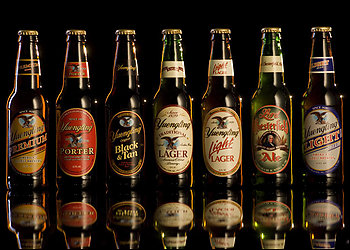 August 28th, 2008
Anheuser Busch . Boston Beer Company . D.G. Yuengling . MillerCoors . SABMiller
August 28th, 2008
Anheuser Busch . Boston Beer Company . D.G. Yuengling . MillerCoors . SABMiller
Time to worry about the big guys?
Should we be worried that American owned macros are a dying breed? I’m not worried yet. With the local craft brewery down the street, I’ll take a fresh draft.
Sean
2Beerguys.com
Drink Craft Beer, You’ve Earned It!!

The Biggest of a Dying Breed
washingtonpost.com
By Greg Kitsock
One year shy of 180, D.G. Yuengling and Son Inc. in Pottsville, Pa., is the oldest continuously operating beermaker in the United States. Depending on your definition of “brewery,” Yuengling might soon boast another distinction: the largest brewery that’s 100 percent U.S.-owned.
Now that Anheuser-Busch (the nation’s largest brewer, with an output of 102 million barrels last year) has accepted InBev’s $52 billion buyout offer, the King of Beers will shortly be part of a Belgian-Brazilian conglomerate. Numbers two and three are likewise international corporations: Miller (40 million barrels last year) was sold to South African Breweries in 2002, and Coors (24 million barrels) merged with Canadian mega-brewer Molson in 2005.
Next up is Pabst (6 million barrels). Pabst “will be the last of the famous iconic U.S. brewers to be fully independent and American-owned,” the company proclaimed in a recent news release. But Pabst sold the last of its physical plants years ago. It rents other people’s tanks (mostly Miller’s) to make Blue Ribbon, Schlitz and about three dozen other budget brands. Can a brewery be a brewery if it lacks mash tuns, brew kettles and fermenters?
Boston Beer Co. (maker of Samuel Adams) turned out almost 1.9 million barrels last year, and it does own several breweries, including a former Pabst plant near Allentown, Pa., that company founder Jim Koch just acquired. But demand exceeds capacity, and in 2007 (estimates New Brewer magazine) Boston Beer contract-brewed 999,000 barrels at other companies’ breweries. If we disqualify Pabst, do we have to subtract those barrels from Boston Beer’s total?
That leaves Yuengling, which last year brewed more than 1.7 million barrels, every last drop at its two plants in Pottsville and one facility in Tampa.
Founded in 1829, Yuengling is privately owned, so it isn’t vulnerable to a hostile takeover the way Anheuser-Busch was. And it’s going to stay that way, insists brewery President Richard L. Yuengling Jr. “I’m the fifth generation of the family that started this thing. I’m 65. I enjoy working,” he says. He has four daughters to carry on after he retires.
The brewery has been a boon to Pottsville, a city whose fortunes have waxed and waned with the anthracite coal industry. The last time Pottsville residents were able to yell “We’re number one!,” the year was 1925 and this coal-region city had a franchise in the fledgling National Football League. The Pottsville Maroons went 10-2 and appeared to have won the NFL championship. But they played a late-season exhibition game in Philadelphia and were suspended by the league — and stripped of their title — for violating another team’s territorial rights.
Sometimes technicalities work for you, sometimes against you.
I don’t know what type of tailgate parties Maroons fans held; it was, after all, Prohibition. But the local brewery is a proper source of refreshment for modern tailgaters.
Yuengling’s brands are “step-up” beers: In terms of flavor, they’re better than the bland national brands, but they’re not so aggressive they would fry the taste buds of a Bud or Miller drinker. Yuengling lightens the beers by adding corn grits, an adjunct that most microbreweries eschew in favor of 100-percent barley recipes.
All of Yuengling’s beers (except the Porter) come in 12-ounce cans, easier to tote and quicker to chill than glass bottles. And you can follow the change of seasons by hopping from one label to another.
During that last summer heat wave at the end of August and into September, suck down a pleasantly malty Yuengling Traditional Lager, the crisper, pale Premium Beer or a Light Lager.
Mark the first frost of autumn by switching to Yuengling Black & Tan, a 60-40 blend of Porter and Premium with that roasty, slightly coffeeish flavor familiar to Guinness drinkers.
As the weather turns frigid in November and December, fortify yourself with unblended Porter or the citrusy Lord Chesterfield Ale, a hoppy pale ale that’s a notch stronger (5.4 percent alcohol by volume) than the brewery’s other offerings. If it’s not too sloppy, mix equal portions of the ale and porter to make a heady blend called a half-and-half.
And what if your team is fortunate enough to still be playing in January?
Dick Yuengling has been conservative not just in politics (he was a delegate for Bush at the 2000 Republican National Convention) but in product development. While other old-time regional breweries such as F.X. Matt in Utica, N.Y., and High Falls in Rochester have introduced craft beer lines and a changing array of seasonals, Yuengling stands pat with a handful of year-round offerings.
“I don’t have the capacity to do seasonals,” says Yuengling, noting that sales are up 7 percent so far this year. “But we’ll probably get into them someday.” When that day comes, the brewery has an archive of old recipes for such styles as brown stout, bock and cream ale, as well as the technical expertise to reproduce whatever the microbreweries are doing.